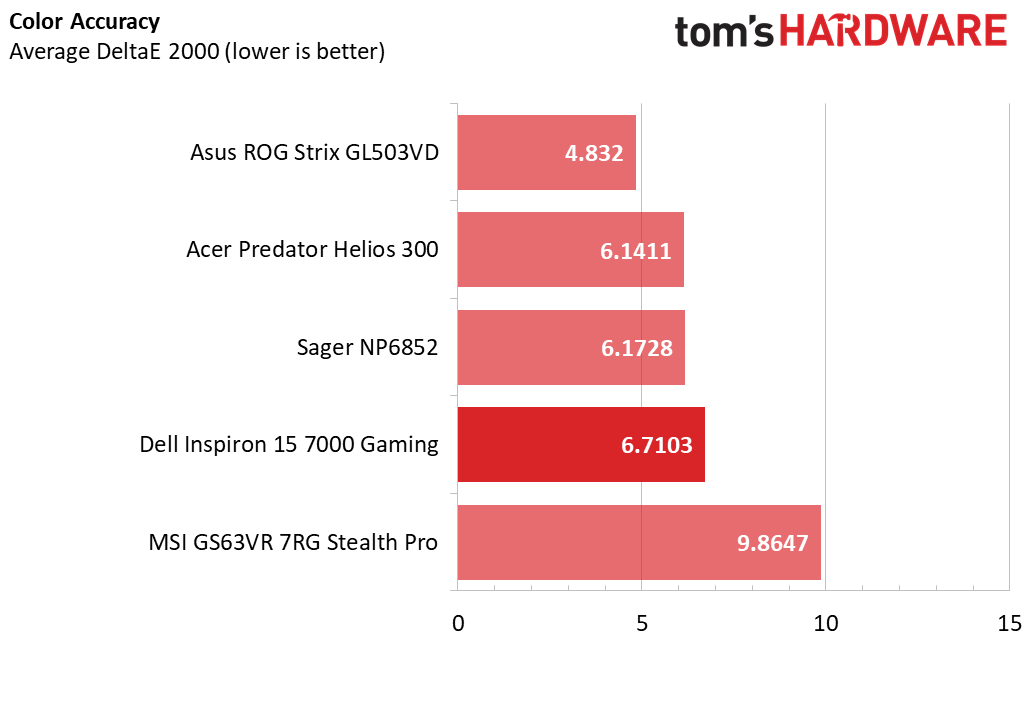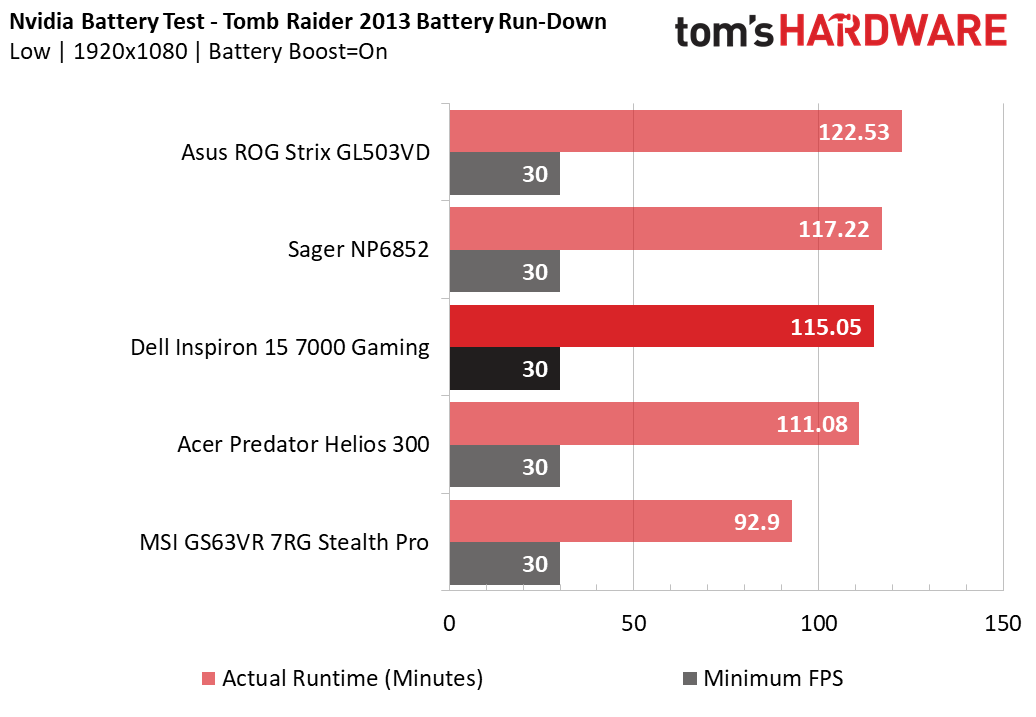Dell Inspiron 15 7000 GTX 1060 Max-Q Gaming Laptop Review
Why you can trust Tom's Hardware
Battery, Thermal & Display Testing
Battery Test - Tomb Raider 2013 Battery Rundown
To test battery life, we set each laptop’s battery profile to Balanced while running Tomb Raider’s built-in benchmark at the lowest detail preset. The frame rate is locked at 30 FPS through GeForce Experience’s Battery Boost to limit the strain on the battery. Meanwhile, a script running in the background monitors and time-stamps the system’s battery percentage. The laptops are set to hibernate once battery levels reach 5%. We test the battery life at 200 nits.
The Dell Inspiron 15 Gaming 7000 is equipped with a four-cell 56Wh battery, which is common in a laptop of this caliber; most of the laptops in this roundup land in the same ballpark. The battery capacities for the competition are as follows: The MSI Stealth Pro has a 51Wh battery, the Asus ROG Strix has a 64Wh, the Acer Helios is at 48Wh, and the Sager NP6852 has 62Wh battery.
The resulting scores are rather straightforward. The Dell’s i5-7300HQ and Max-Q GTX 1060 consume less power than an i7-7700HQ and a powerful GPU, so it outputs close to 2 hours of uninterrupted game time.
The competition is rather tight, even with the Inspiron’s considerably reduced power requirements. For one, the Acer Helios is running a Core i7 and a standard GTX 1060 on a smaller battery, but only loses a few minutes of game time against the Inspiron. Conversely, the Sager has a larger battery and an i7, but its GTX 1050 Ti is more power efficient, netting it two additional minutes of game time. The only system the Inspiron definitively outlasts is the MSI Stealth Pro, whose i7, smaller batter, and more demanding Max-Q GTX 1070 produce around 90 minutes of game time.
Thermal Testing
Typically, we use our Optris PI 640 infrared camera to measure the laptop’s thermals. However, the Inspiron 15’s internal structure features a large plastic shroud which obscures the cooling solution, preventing us from getting an accurate reading. For situations like these, we can use the average and maximum temperature from a GPU-Z’s thermal log. For more information about how we test, be sure to check out our Measurement Science article.
We’ve noted that the Inspiron is the thickest Max-Q laptop we’ve tested, and this allows Dell to implement a larger cooling solution. On top of that, the i5 and Max-Q GTX 1060 consume less power, thus expelling less heat. As a result, the Inspiron runs the coolest out of the laptops in our roundup, even after a grueling Furmark stress test. It reaches a maximum temperature of 60° C, underscoring the Acer Helios by a couple degrees. This is a noteworthy feat, especially considering that the Helios’s thermal performance was one of the crowning achievements earning it our Editor’s Choice award. If you live in a warm climate and thermal performance is crucial, then the Inspiron will serve you well.
Display Testing
We used the SpectraCal C6 Colorimeter to measure the Dell Inspiron's display. We tested it using MSI’s default sRGB True Color profile. (Check out our Display Testing Explained article for a full description of our test methodology.)
Get Tom's Hardware's best news and in-depth reviews, straight to your inbox.






We noted in our introduction that the Inspiron features a Full HD IPS display, which is excellent for the price. A great display should aim for a contrast ratio of 1000:1, but this isn’t expected from an entry-level gaming laptop. At minimum brightness, it exhibits the lowest minimum white luminance, but this is offset by its equally low black luminance, earning it a decent contrast ratio of 867.7:1. Similarly, it has a low maximum white luminance of 233.311 and a low maximum black luminance of 0.2525, resulting in a contrast ratio of 924.1:1, which is much better than its minimum score.
The Inspiron’s RGB levels aren’t as balanced as we’d like them to be. Starting from minimum brightness, the red and green levels are slightly recessed, while the blue level is pronounced. As brightness is increased, blues continue to rise, while reds and greens fall. The resulting image has a slight blue tint.



DeltaE 2000 is a measurement of display accuracy, and it can be used to determine how accurate the grayscale measurements are. A DeltaE 2000 value of 3 or lower is ideal, as this means that the inaccuracies are not noticeable to the human eye. Grayscale is intricately tied to RGB balance, so the more unbalanced your levels, the more inaccurate the grayscale is. As such, the grayscale starts fairly accurate, but it loses accuracy as brightness is increased. The tipping point is around 50%, and values higher are noticeably inaccurate. The resulting average DeltaE 2000 is 3.622, with a maximum of close to 8 at 100% brightness.
A well-saturated display will have an average gamma of 2.2; larger values mean the display is oversaturated, and vice versa. The Inspiron’s gamma rises as brightness is increased to around 36%. After that, increasing the brightness results in a drop in the gamma point chart. This means that low brightness levels are noticeably oversaturated, while high brightness levels are undersaturated.
Color accuracy is measured in DeltaE 2000, same as grayscale, so a color-accurate display will exhibit a DeltaE below 3. Unfortunately, the Inspiron’s display is less color-accurate than it is grayscale-accurate. It has a DeltaE 2000 value of 6.7103, dropping to fourth place in our roundup. Greens, blues, cyans, and magentas are particularly inaccurate across the board, and reds and yellows lose accuracy as the brightness level is increased.
It should be restated that the systems in this roundup (save for the MSI Stealth Pro) aren’t expensive laptops, and one shouldn’t expect a painstakingly accurate display from an entry-level gaming laptop. If gaming is your primary concern, then color accuracy likely isn't nearly as important.
MORE: Best Gaming Laptops
MORE: Gaming Laptop Previews
MORE: All Laptop Content
Current page: Battery, Thermal & Display Testing
Prev Page Gaming Benchmarks Next Page Price Analysis & Conclusion-
AgentLozen I like Dell's approach to Max-Q with this design. Using Max-Q to reduce temperatures and power consumption would be ideal with a GTX 1070 or 1080. We keep seeing laptops that are super tiny and thin with no room for expansion. I want to see a normal sized laptop with a GTX 1070 and TERRIFIC thermal performance that can hold an M.2 SSD and a 2.5" mechanical hard drive.Reply -
fullauto2009 Ive seen this refurbished for 615.Reply
Ive also bought this new from costco for 700
So once you factor that in its a really solid deal

